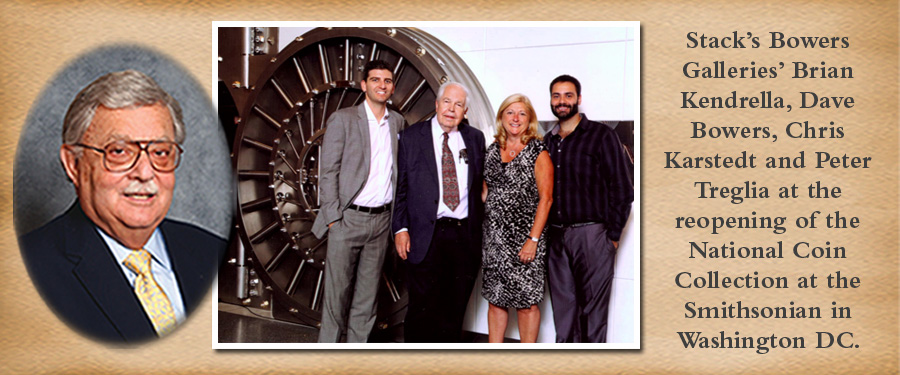
The following article is excerpted from Harvey Stack’s article published online at Coinweek.com, July 16, 2015.
On July 15, 2015, the National Numismatic Collection was returned to the displays at the Smithsonian. For close to a decade, portions of the National Collection were not exhibited as the Museum of American History at the Smithsonian was reduced in size and the museum went through major renovation.
Today, the National Numismatic Collection is housed in a special exhibit room, in all its glory, on the first floor of the Museum. In this location it will be more accessible and seen by many more visitors.
I have been involved with the National collection, since the mid 1940s. Being from a numismatic family I was attracted all such displays. I remember my first visit to the Smithsonian, after World War II, when I traveled with my parents and sister from New York to Washington D.C. and on to Baltimore. Our stop in Washington included a visit to see the National Numismatic Collection. We found the exhibit in the lower level of the Smithsonian Castle, almost below street level, with large windows to help illuminate the display. The pieces were arranged in long flat showcases, coins side-by-side, top and bottom, and one had to look down to see the items. The overhead electric lighting was so-so at best, and the tags were not always legible. We visited the curator, Stuart Mosher, whom my father had known for a number of years, and we were escorted about the displays. For someone like me, who had already developed a major interest in numismatics, it was exciting to see some of the great rarities. But it was hard to learn very much from the way it was displayed.
After our visit to the museum, we continued on to Baltimore to visit some of my father’s cousins, and we also visited with Louis E. Eliasberg and his good friend Philip Strauss. When I saw the way Eliasberg stored his coins, in National Cardboard holders with the coins protected by acetate slides, I had the opportunity to view closely many of the rarities and really learn from what I saw.
In the mid 1950s, Vladimir Stefanelli and his wife, who had worked for Stack’s for close to a decade, were offered and accepted the job as curator of the National Numismatic Collection. As both Stefanellis were academics and students of numismatics, we at Stack’s were pleased for them when they accepted this honor and privilege. Our friendship continued to the days they both retired.
At the same time that the Stefanellis took their new job, the National Numismatic Collection moved from the Castle to the new building. The Collection was put on display in a large exhibition room. It was well lit and attracted many.
As the Collection grew from donations, loans from the Mint Collection (which is now part of the National Collection), private donors and acquisitions by families like ours, Stack’s decided to continue to work to make our National Collection the best in the world.
In the early 1960s, the Collection was expanded by Willis du Pont’s donation of the Michailovich Collection of Russian Coins, (one of the most complete and outstanding known). By a 1968 Act of Congress, the Josiah K. Lilly Gold Coin Collection, consisting of 6,150 different World gold coins and one of the most complete collections of U.S. Gold ever assembled went to the Smithsonian. The Lilly cabinet, which Stack’s built for him between 1951 and 1967, helped make the National Coin Collection one of the most outstanding collections of numismatics ever assembled, public or private.
During the development of the National Coin Collection into its present state, the Stack family made numerous donations from their own collections and funded many acquisitions that were needed by the museum. Though we never counted the number of pieces we gave, we were told that the Stack family gave over 60,000 pieces. From the mid-1950s to now, the collection has amassed over two million numismatic items, including a vast collection of proofs and art from the Bureau of Engraving and Printing and a major collection of Broken Bank and Confederate notes.
Among the outstanding items that the Stack family donated was the 1794 dollar in copper, believed struck before the first dollars were struck in silver. There was also a pair of quintuple Stellas (patterns for a “universal” trade $20 gold coin equal to the five-pound piece, the French 100-franc piece and the Italian 100 lire), as well as the original Charles Barber papers, which included drawings, designs and notes. There were even 135 pairs of ancient coin dies, used to make counterfeits of Ancient coins that eventually found their way into Royal Collections; many are still considered genuine, as the dies were so exact.





